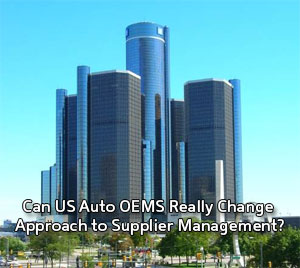“Initially this was considered a success by the domestic automotive manufacturers, and Ford and Chrysler followed the GM lead,” Michels told us. “The failure in his approach was that the focus was entirely based on price reduction and virtually no focus on real cost reductions. Suppliers dependent on high volumes continued to meet the requirement for price reduction eroding margins until the entire supply chain was virtually bankrupt.”
Now, with the big three all under various states of financial duress and still worries about their ability to survive, a change in the current supplier model simply has to change, Michels says.
“It's becoming clear from Detroit to Washington, D.C., that the supply chain will be playing an increasing important role for domestic auto manufacturers,” he says. “With R&D dollars scarce, and huge technological transitions ahead of them, OEMs need suppliers to bring them innovations, and no smart supplier is going to send its best new technology to its worst customer.”
He believes that the key to success for the domestic automakers is to complete a supply chain analysis and “lean out” the supply chain to eliminate waste and true cost. Without attacking the real cost, he says, the industry will remain uncompetitive to the international competition who do take a cost-based approach.
“They really work with suppliers to attack cost while keeping supplier margins healthy,” Michels says. “This is the real contrast in procurement philosophy that brings innovation, investment and competitive advantage to companies like Toyota and Honda.”
 He says that while the US OEMs have supplier development programs to an extent, they have a very narrow focus. He says that while the US OEMs have supplier development programs to an extent, they have a very narrow focus.
“The US OEMs have taken a competitive leverage approach to the supply base where suppliers are only as good as the last price and the business is always at risk,” Michels says. “While there are supplier development programs, many of those efforts were primarily focused on supplier quality.”
He says a strong supplier development and supplier relationship program would focus on productivity, efficiency, waste, and innovation, which is how Toyota and Honda structure their programs. With this approach, supplier margins are transparent and maintained, and the product development process is focused on true total cost across multiple tiers. Suppliers are part of the new product development process and a target cost approach is used.
“This is a design for manufacturing approach and suppliers are a key factor in its success,” Michels says.
Michels calls on GM’s Socia to pursue five changes in its approach to supplier management:
1) Focus effort to rebuild the supply chain. The discussion now is about eliminating suppliers, but the real work will be to build strategic relationships with those that remain. Choosing winners should not be based on the simplistic price formulas of the past, but on deep analyses of the long-term prospects of a supplier delivering innovation, sustainable prices and low risk.
2) Stop looking at the supply base as a source of incremental profit by insisting on price cuts every year. Recognize that suppliers are an extension of GM's manufacturing capability. When they fail, GM falls behind.
3) Develop suppliers with the capability to generate high productivity and automation. Many of the transplant automotive competitors have been focusing their energy in Alabama, Mississippi and Georgia to capitalize on low-cost domestic suppliers. GM should look for those companies that maintain high factory utilization by building a sustainable capacity instead of overbuilding, hoping to amortize the investment based on unrealistic sales projections.
4) Launch a formal supplier development and support program focused on supply chain optimization. That means moving forward into deeper relationships with those firms that have the intellectual property, management skills and production experience to succeed as GM rebuilds.
5) Build a better risk management program with predictive modeling. GM needs to quickly identify the suppliers that are not going to survive a summer shutdown or the current 180-day terms for payments. Even after these immediate threats are gone, GM needs a better ongoing risk management program.
“I do not believe that a new VP will make the difference; I do believe the industry will be forced into changing the relationships, focus, direction or it will continue to lose ground to the Japanese competition and its suppliers,” Michels says.
Have the US auto OEMs really hurt themselves in the end by their approach with suppliers, or has this been exaggerated? Can they really change now? Is supply chain collaboration critical to their eventual recovery? Let us know your thoughts at the Feedback button below.
|